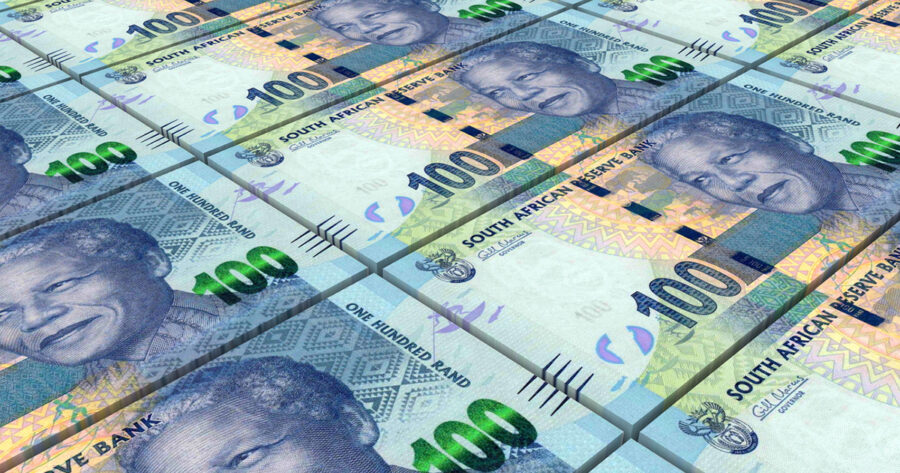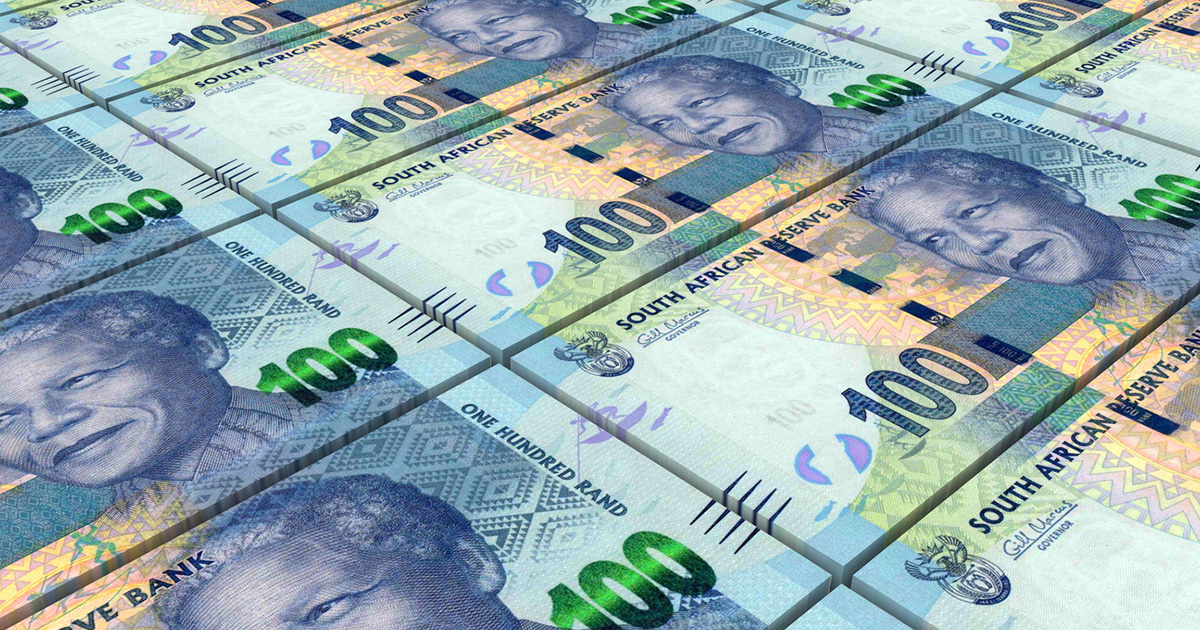
South African rand strengthened ahead of inflation data
The South African rand strengthened against the dollar on Tuesday, ahead of closely-watched local inflation figures which could offer investors clues on the central bank’s potential rate path.

Reuters: The South African rand strengthened against the dollar on Tuesday, ahead of closely-watched local inflation figures which could offer investors clues on the central bank’s potential rate path at its next policy meeting next month.
FAQ: Could the South African Rand hit R25 to the Dollar?
SOUTH AFRICAN RAND STRENGTHENED
At 1539 GMT, the rand traded at 18.7425 against the dollar, nearly 0.2% firmer than its previous close. The rand has had a strong start to the week, jumping over 1% on Monday as market sentiment improved, despite the conflict in the Middle East. The dollar index was last down 0.18% against a basket of major currencies.
The South African Reserve Bank said on Tuesday that upside risks to inflation had strengthened over the past months, heightening uncertainty about a precise path for inflation. In its October Monetary Policy Review, the SARB said the rise in oil prices, dry weather conditions and elevated inflation expectations were all negatively impacting the inflation outlook. Focus on Wednesday will now be on Statistics South Africa, which will release September consumer inflation data at about 0800 GMT.
However, analysts have warned that the rand, like most emerging market currencies, also continues to be swayed by other international developments such as the war between Israel and the militant group Hamas, and U.S. monetary policy. Shares on the Johannesburg Stock Exchange closed lower, with the blue-chip Top-40 index ending down nearly 0.4%. South Africa’s benchmark 2030 government bond was weaker, the yield up 2.5 basis points to 10.760%.
ALSO READ: Rand Report: South African Rand finally showing signs of life
U.S. DOLLAR
Reuters: The South African rand strengthened against the dollar on Tuesday, ahead of closely-watched local inflation figures which could offer investors clues on the central bank’s potential rate path at its next policy meeting next month. At 1539 GMT, the rand traded at 18.7425 against the dollar, nearly 0.2% firmer than its previous close. The rand has had a strong start to the week, jumping over 1% on Monday as market sentiment improved, despite the conflict in the Middle East. The dollar index was last down 0.18% against a basket of major currencies.
The South African Reserve Bank said on Tuesday that upside risks to inflation had strengthened over the past months, heightening uncertainty about a precise path for inflation. In its October Monetary Policy Review, the SARB said the rise in oil prices, dry weather conditions and elevated inflation expectations were all negatively impacting the inflation outlook. Focus on Wednesday will now be on Statistics South Africa, which will release September consumer inflation data at about 0800 GMT.
However, analysts have warned that the rand, like most emerging market currencies, also continues to be swayed by other international developments such as the war between Israel and the militant group Hamas, and U.S. monetary policy. Shares on the Johannesburg Stock Exchange closed lower, with the blue-chip Top-40 index ending down nearly 0.4%. South Africa’s benchmark 2030 government bond was weaker, the yield up 2.5 basis points to 10.760%.
ALSO READ: Thembani Xulu: From waste picker to recycling tycoon
BRITISH POUND
Reuters: Sterling fell on Tuesday after data showed that growth in British workers’ regular pay slowed from a previous record high and job vacancies also declined, with a softer labour market boosting the chance the Bank of England will hold rates unchanged. Sterling fell 0.4% against the dollar to $1.2169, moving towards a one-week low hit last Friday. It was down 0.4% against the euro at 86.75 pence, just off an almost two-week low touched on Monday. In a sign that the labour market is losing momentum, job vacancies declined and British average earnings, excluding bonuses, were 7.8% higher than a year earlier during the three months to August, down from an upwardly revised 7.9% in the three months to July, marking the first such fall since January.
The publication of some labour market data, including the unemployment rate, was delayed until next week. The BoE is keeping a close eye on the labour market – especially earnings figures – as it tries to gauge whether it needs to resume raising interest rates, having opted to keep them on hold in September after 14 hikes in a row. “The pound has suffered sharp losses this morning, following the release of annual earnings data that saw wage growth outstrip inflation for the first time since October 2021,” said Joshua Mahony, chief market analyst at Scope Markets.
“Nonetheless, with the BoE undoubtedly concerned at the rise of wages over recent months, today’s decline eases concerns that we could see another rate hike in the near term.” Analysts at Nomura said the weakening job data could help the Monetary Policy Committee to decide the direction of travel in rates. Nomura told investors in a note that they expect the first rate cut from the third quarter next year, while based on the latest data, they think the hiking cycle is over. Money markets now see a 77% chance that the BoE will hold rates unchanged in its coming meeting in November. Another key macro-economic release this week is Britain’s consumer price index due on Wednesday.
ALSO READ: SASSA may soon go on STRIKE!
GLOBAL MARKETS
Reuters: Asian shares steadied on Wednesday as Chinese economic data suggested Beijing’s stimulus measures might finally be gaining traction, only to be overshadowed by fears of a widening conflict in the Middle East that lifted oil prices. Global bond markets were also still nursing heavy losses as strong U.S. retail data argued for a punishingly long stretch of high rates. The outlook for the world economy did seem to take a turn for the better as China reported annual economic growth of 4.9% in the third quarter, beating forecasts for 4.4%. Retail sales and industrial output for September surprised on the upside, suggesting activity was gaining momentum. That could not stop Chinese blue chips slipping 0.5% as cautioned gripped markets.
The mood had been darkened as Israeli and Palestinian authorities traded blame for the blast that killed hundreds at a Gaza hospital, complicating U.S. President Joe Biden’s already fraught trip to the region. The news contributed to a spike in oil prices as investors worried Iran or other nations could get pulled in. “We judge the risks are tilted towards escalation and spread of the Israel-Hamas conflict to other countries in the Middle East,” warned analysts at CBA in a note. “A major spike in volatility and a downgrade of the global economic growth outlook is possible.”
The sober mood left MSCI’s broadest index of Asia-Pacific shares outside Japan 0.1% lower, while Japan’s Nikkei dipped 0.2%. EUROSTOXX 50 futures and FTSE futures were both flat. S&P 500 futures eased 0.2% and Nasdaq futures 0.1%. Tech stocks were dragged in part by a drop in Nvidia after news the Biden administration plans to halt shipments to China of more of its advanced artificial intelligence chips. Markets are now anxiously awaiting earnings from Netflix and Tesla later in the session.
ALSO READ: Limpopo farmer transforms dream into reality
Stocks were also pressured by a jump in bond yields after a barnstorming report on September U.S retail sales sent analysts scurrying to revise up forecasts for economic growth for both the third and fourth quarters. JPMorgan jacked its growth call up to an annualised 4.3%, from 3.5%, while the influential Atlanta Fed GDPNow prediction jumped to a heady 5.4%. Markets reacted by pricing in more risk the Federal Reserve will be forced to hike again. A move in November is still seen as just an 11% chance, but January climbed to 50% from 37%.
The market also again scaled back expectations for early rate cuts, with no chance of a move until June and around 54 basis points of easing implied for all of 2024. Bonds took it badly, with two-year yields surging as much as 14 basis points on Tuesday to a 16-year peak of 5.24%. The two-year was last at 5.20%, while 10-year yields were back near recent highs at 4.84%. The surge rippled through world bonds, with the Bank of Japan forced to conduct an unscheduled operation to buy JGBs to restrain a rise in yields. More Fed comments are likely on Wednesday with no less than five officials speaking, ahead of an appearance by Chair Jerome Powell on Thursday.
The rise in yields underpinned the U.S. dollar, particularly on the low-yielding Japanese yen where the dollar reached 149.69 to again threaten major resistance at 150.00. The euro eased back a touch to $1.0573 , having been as high as $1.0595 on Tuesday. Safe-haven flows lifted gold 0.7% to $1,938 an ounce , well above its recent trough of $1,809. Oil prices swung higher once more, driven by concerns over the Middle East and data showing a fall in crude stocks. Brent climbed $1.76 to $91.66 a barrel, while U.S. crude rose $1.91 to $88.57 per barrel.
ALSO READ: Pick n Pay CEO Sean Summers hits the ground running: ‘We have a lot of work to do’
Published by the Mercury Team on 18 October 2023
For more news on global and local market performance, follow our business and finance page.
